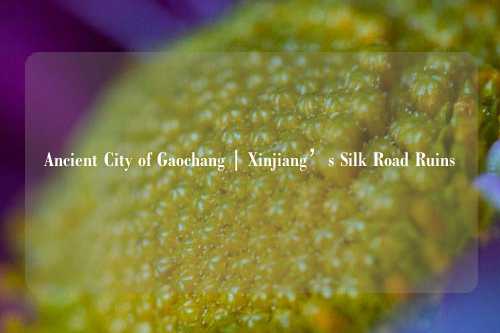Ancient City of Gaochang | Xinjiang’s Silk Road Ruins
The Ancient City of Gaochang, located in the Turpan Depression of Xinjiang, is a bewitching treasure trove of history and culture. Once known as the "Pearl of the Silk Road," this site was a stop for travelers and traders connecting China with the West. Today, Gaochang stands as a silent sentinel of the past, offering visitors a window into the辉煌 history of the region.
Gaochang’s story begins in the 3rd century BCE, when it was established as a key outpost along the Silk Road. Its location at the crossroads of Central Asia made it a melting pot of cultures, religions, and traditions. Merchants from China, Persia, and the Mediterranean brought not only goods but also ideas, art, and faiths to the city. This synthesis is evident in the diverse range of archaeological remains and inscriptions found throughout the site.

The city’s layout is a testament to its role as a thriving metropolis. The imposing city walls, which stretch over 1.5 kilometers in circumference, were built to protect the city from external threats. The walls are a marvel of ancient engineering, showcasing the ingenuity of the people who lived here. Within the walls, the remnants of palaces, temples, and residential quarters provide a glimpse into the daily lives of the city’s inhabitants.
One of the most aspects of Gaochang is its role as a center of exchange. The city was home to a diverse population, including Han Chinese, Xiongnu nomads, and Sogdian merchants. This diversity is reflected in the artwork and artifacts found in the nearby Bezeklik Caves. These caves, which are part of the larger Turpan Caves complex, contain a mix of Buddhist and Manichaean imagery, showcasing the city’s syncretic religious practices.
Despite its grandeur, Gaochang’s existence was not without its challenges. The city faced numerous invasions and shifts in political power over the centuries. By the 14th century, Gaochang had fallen into decline, and its once-bustling streets becameEmpty. However, efforts in recent decades to preserve and restore the site have brought it back to life, allowing modern visitors to marvel at its former glory.
A visit to the Ancient City of Gaochang is like stepping into a living museum, where the echoes of the Silk Road still reverberate. The site is a labyrinth of narrow streets, ruined gateways, and subterranean passages that invite exploration and wonder. Each corner of the city seems to hold a story, waiting to be uncovered by the curious traveler.
One of the highlights of Gaochang is its well-preserved city walls, which are a testament to the ingenuity of ancient engineers. The walls were constructed using a mixture of clay, reeds, and straw, which made them both strong and flexible. The city’s system also included watchtowers and gatehouses, which served to protect the city from marauding tribes and rival states.
Another must-see attraction is the Bezeklik Caves, which are located a short distance from the city. These caves, which date back to the 5th century, are a treasure trove of art and religious imagery. Visitors can marvel at the murals depicting scenes from Buddhist, Manichaean, and even Christian traditions. The caves also provide insights into the daily lives of the people who lived in Gaochang, offering a glimpse into the region’s and religious history.
For those interested in the city’s commercial past, the remains of the Gaochang Market are a sight. This market, which was once a bustling hub of trade, is now reduced to a series of ruined stalls and warehouses. The site gives a picture of the city’s role as a center of commerce, where merchants from across the region gathered to exchange goods, ideas, and stories.
The nearby Juyanhai Swimming Pool, also known as the “Heavenly Pool,” is another highlight of the Gaochang site. This man-made reservoir was an essential source of water for the city, and its construction reflects the ingenuity of the city’s inhabitants. The pool’s serene waters and surrounding gardens provide a peaceful contrast to the rugged landscape of the Turpan Depression, offering a welcome respite for weary travelers.
In addition to its historical significance, Gaochang is also a UNESCO World Heritage Site, recognizing its importance as a crossroads of Central Asia. The site is part of the larger Silk Road Network, which spans over 40 countries and includes some of the world’s most iconic historical sites. For history enthusiasts and travelers alike, a visit to Gaochang is an opportunity to connect with the rich and diverse heritage of the Silk Road.
, the Ancient City of Gaochang is more than just a collection of ruins; it is a living testament to the vibrancy and resilience of the Silk Road. Whether you are captivated by the city’s architectural marvels, intrigued by its heritage, or simply looking for a travel experience, Gaochang promises to leave a lasting impression. So why not pack your bags and embark on a journey to this enchanting city? You won’t regret it.
















